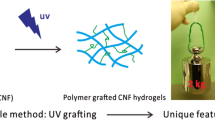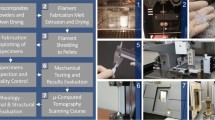Abstract
Cellulose nanocrystals (CNC) can be embedded within hydrogels to form tough and strong nanocomposite materials, which possess biomimetic properties from hydrogels including good biocompatibility, permeability and flexible mechanical characteristics. There are many potential applications for these strong nanocomposite hydrogels in medical devices, such as wound dressing or super absorbents. Whereas, the research on the mechanical properties of CNC reinforced nanocomposite remains at superficial level, and their nonlinear mechanical responses are rarely investigated in previous reports. Mechanical characteristics of CNC reinforced poly(2-hydroxyethyl methacrylate) (PHEMA) nanocomposite hydrogels, in terms of stress–strain correlations, fracture mechanism, and cyclic stretching responses, have been investigated in this work. Experimental results show that the modulus of the nanocomposite hydrogel tends to increase with increasing CNC content. Theoretical foundation for analysing the mechanical properties of hydrogels based on Mooney–Rivlin hyperelastic model, Voigt model and Reuss model has been developed and validated, which provides the prediction of the mechanical responses of CNC reinforced nanocomposite hydrogel to tension, especially the nonlinear responding behaviour.








Similar content being viewed by others
References
Abitbol T, Johnstone T, Quinn TM, Gray DG (2011) Reinforcement with cellulose nanocrystals of poly(vinyl alcohol) hydrogels prepared by cyclic freezing and thawing. Soft Matter 7:2373
Alger M (1997) Polymer science dictionary (2nd ed). Springer, New York. ISBN 0412608707
Alloin F, d’Aprea A, Dufresne A, El Kissi N, Bossard F (2011) Poly(oxyethylene) and ramie whiskers based nanocomposites. Influence of processing: extrusion and casting/evaporation. Cellulose 18:957–973
Anglès MN, Dufresne A (2000) Plasticized starch/tunicin whiskers nanocomposites: 1. Structural analysis. Macromolecules 33:8344–8353
Anssari-Benam A, Bader DL, Screen HRC (2011) A combined experimental and modelling approach to aortic valve viscoelasticity in tensile deformation. J Mater Sci Mater Med 22:253–262
Araki J, Kuga S (2001) Effect of trace electrolyte on liquid crystal type of cellulose microcrystals. Langmuir 17(15):4493–4496
ASTM International, US (2010) D638-10, standard test method for tensile properties of plastics, 3–4
Azizi Samir MAS, Alloin F, Sanchez J, Kissi NE, Dufresne A (2004) Preparation of cellulose whiskers reinforced nanocomposites from an organic medium suspension. Macromolecules 37(4):1386–1393
Baudoin R, Griscom L, Monge M, Legallais C, Leclerc E (2007) Development of a renal microchip for in vitro distal tubule models. Biotechnol Prog 23:1245–1253
Bostan L, Munteanu F, Popa MI, Verestiuc L (2010) Preliminary studies on fatigue analysis of hydrogels based on PHEMA. Rev Chim 61(12):1235–1238
Braun B, Dorgan JR (2008) Single-step method for the isolation and surface functionalization of cellulosic nanowhiskers. Biomacromolecules 10(2):334–341
Calvert P (2009) Hydrogels for soft machines. Adv Mater 2009:743–756
Compan V, Andrio A, Lopez-Alemany A, Riande E, Refojo MF (2002) Oxygen permeability of hydrogel contact lenses with organosilicon moieties. Biomaterials 23:2767–2772
Eichhorn SJ (2011) Cellulose nanowhiskers: promising materials for advanced applications. Soft Matter 7:303–315
Farkish A, Fall M (2013) Rapid dewatering of oil sand mature fine tailings using super absorbent polymer (SAP). Miner Eng 50:38–47
Gao X, Shi Z, Liu C, Yang G, Sevostianov I, Silberschmidt V (2015) Inelastic behaviour of bacterial cellulose hydrogel: in aqua cyclic tests. Polym Test 44:82–92
Gao X, Shi Z, Kusmierczyk P, Liu C, Yang G, Sevostianov I, Silberschmidt VV (2016a) Time-dependent rheological behaviour of bacterial cellulose hydrogel. Mater Sci Eng C 58:153–159
Gao X, Shi Z, Lau A, Liu C, Yang G, Silberschmidt V (2016b) Effect of microstructure on anomalous strain-rate-dependent behaviour of bacterial cellulose hydrogel. Mater Sci Eng C 62:130–136
Gennaro R, Greco A, Maffezzoli A (2010) Numerical simulation of the microscale impregnation in commingled thermoplastic composite yarns. Adv Polym Technol 29:122–130
George J, Sajeevkumar AV, Ramana KV, Sabapathy SN, Siddaramaiah (2012) Augmented properties of PVA hybride nanocomposites containing cellulose nanocrystals and silver nanoparticles. J Mater Chem 22:22433–22439
Hubbe MA, Rojas OJ, Lucia LA, Sain M (2008) Cellulosic nanocomposites-A review. BioResources 3(3):929–980
Jonoobi M, Oladi R, Davoudpour Y, Oksman K, Dufresne A, Hamzeh Y, Davoodi R (2015) Different preparation methods and properties of nanostructured cellulose from various natural resources and residues: a review. Cellulose 22:935–969
Kargarzadeh H, Sheltami RM, Ahmad I, Abdullah I, Dufresne A (2015) Cellulose nanocrystal: a promising toughening agent for unsaturated polyester nanocomposite. Polymer 56:346–357
Kimelaman-Bleich N, Pelled G, Sheyn D, Kallai I, Zilberman Y, Mizrahi O, Tal Y, Tawackoli W, Gazit Z, Gazit D (2009) The use of a synthetic oxygen carrier-enriched hydrogel to enhance mesenchymal stem cell-based bone formation in vivo. Biomaterials 30(27):4639–4648
Korpe S, Erdogan B, Bayram G, Ozgen S, Uludag Y, Bicak N (2009) Crosslinked DADMAC polymers as cationic super absorbents. React Funct Polym 69(9):660–665
Lin N, Dufresne A (2013) Physical and/or chemical compatibilization concentration of extruded cellulose nanocrystal reinforced polystyrene nanocomposites. Macromolecules 46:5570–5583
Lin N, Huang J, Dufresne A (2012) Preparation, properties and applications of polysaccharide nanocrystals in advanced functional nanomaterials: a review. Nanoscale 4:3274–3294
Lionetto F, Calo E, Di Benedetto F, Pisignano D, Maffezzoli A (2014) A methodology to orient carbon nanotubes in a thermosetting matrix. Compos Sci Technol 96:47–55
Liu J, Li Q, Su Y, Yue Q, Gao B (2014) Characterization and swelling–deswelling properties of wheat straw cellulose based semi-IPNs hydrogel. Carbohydr Polym 107:232–240
Magalhaes WLE, Cao XD, Lucia LA (2009) Cellulose nanocrystals/cellulose core-in-shell nanocomposite assemblies. Langmuir 25(22):13250–13257
Marckmann G, Verron E (2006) Comparison of hyperelastic models for rubber-like materials. Rubber Chem Technol 79:835–858
Mariano M, Kissi NE, Dufresne A (2014) Cellulose nanocrystals and related nanocomposites: Review of some properties and challenges. J Polym Sci B Polym Phys 52:791–806
Mark JE (1981) Rubber elasticity. J Chem Educ 58:898–903
Moon RJ, Martini A, Nairn J, Simonsen J, Youngblood J (2011) Cellulose nanomaterials review structure, properties and nanocomposites. Chem Soc Rev 40:3941–3994
Mooney M (1940) A theory of large elastic deformation. J Appl Phys 11(9):582–592
Moraisa JPS, de Freitas Rosa M, de sá Moreira de Souza Filho M, Nascimento LD, Nascimento DM, Cassales AR (2013) Extraction and characterization of nanocellulose structures from raw cotton linter. Carbohy Polym 91(1):229–235
Ogden RW (1972) Large deformation isotropic elasticity on the correlation of theory and experiment for incompressible rubberlike solids. Proc R Soc Lond A 326:565–584
Peppas NA, Benner RE (1980) Proposed method of intracordal injection and gelation of poly(vinyl alcohol) solution in vocal cords: polymer considerations. Biomaterials 1(3):158–162
Perale G, Rossi F, Santoro M, Peviani M, Papa S, Llupi D, Torriani P, Micotti E, Previdi S, Cervo L, Sundstrom E, Boccaccini AR, Masi M, Forloni G, Veglianese P (2012) Multiple drug delivery hydrogel system for spinal cord injury repair strategies. J Control Release 159(2):271–280
Pinho E, Henriques M, Soares G (2014) Cyclodextrin/cellulose hydrogel with gallic acid to prevent wound infection. Cellulose 21:4519–4530
Reuss A (1929) Berechnung der Fließgrenze von Mischkristallen auf Grund der Plastizitätsbedingung für Einkristalle. J Appl Math Mech 9:49–58
Rivlin RS (1948) Large elastic deformations of isotropic materials. In further development of the general theory. Philos Trans R Soc Lond A 241(835):379–397
Rusli R, Shanmuganathan K, Rowan SJ, Weder C, Eichhorn S (2011) Stress transfer in cellulose nanowhisker—composites-influence of whisker aspect ratio and surface charge. Biomacromolecules 12(4):1363–1369
Screen HRC, Lee DA, Bader DL, Shelton JC (2004) An investigation into the effects of the hierarchical structure of tendon fascicles on micromechanical properties. Proc Inst Mech Eng H 218:109–119
Segal L, Greely L, Martin AE, Conrad CM (1959) An empirical method for estimating the degree of crystallinity of native cellulose using X-ray diffractometer. Text Res J 29(10):784–794
Takayanagi M, Uemura S, Minami S (1964) Application of equivalent model method to dynamic rheooptical properties of crystalline polymer. J Polym Sci Polym Symp 5(1):113–122
Tan R, She Z, Wang M, Fang Z, Liu Y, Feng Q (2012) Thermo-sensitive alginate-based injectable hydrogel for tissue engineering. Carbohydr Polym 87(2):1515–1521
Tashiro K, Kobayashi M, Tadokoro H (1977) Elastic moduli and molecular structures of several crystalline polymers, including aromatic polyamides. Macromolecules 10:413–420
Tatsumi M, Teramoto Y, Nishio Y (2015) Different orientation patterns of cellulose nanocrystal films prepared from aqueous suspensions by shearing under evaporation. Cellulose 22:2983–2992
Teixeira JA, Mota M, Venancio A (1994) A model identification and diffusion coefficients determination of glucose and malic acid in calcium alginate membrane. Chem Eng J 56:B9–B14
Ul-Islam M, Khan T, Khattak WA, Park JK (2013) Bacterial cellulose-MMTs nanoreinforced composite films: novel wound dressing material with antibacterial properties. Cellulose 20:589–596
Voigt W (1889) Ueber die Beziehung zwischen den beiden Elasticitätsconstanten isotroper Körper. Ann Phys 274:573–587
Wilson AN, Guiseppi-Elie A (2014) Targeting homeostasis in drug delivery using bio-responsive hydrogel microforms. Int J Phamaceutics 461(1–2):214–222
Yang J, Han CR, Duan JF, Ma MG, Zhang XM, Xu F, Sun RC (2013a) Synthesis and characterization of mechanically flexible and tough cellulose nanocrystals–polyacrylamide nanocomposite hydrogels. Cellulose 20:227–237
Yang J, Han CR, Duan JF, Xu F, Sun RC (2013b) Mechanical and viscoelastic properties of cellulose nanocrystals reinforced poly(ethylene glycol) nanocomposite hydrogels. ACS Appl Mater Interface 5(8):3199–3207
Yang J, Zhao J, Xu F, Sun RC (2013c) Revealing strong nanocomposite hydrogels reinforced by cellulose nanocrystals: insight into morphologies and interactions. ACS Appl Mater Interface 5(24):12960–12967
Zhao W, Liu C, Lenardi C, Santaniello T, Wu F (2012) Mechanical fastening to enable room temperature packaging for LOCs based on biocompatible hydrogel thin film. In: Proceedings of the 14th international conference on electronics materials and packaging, December 13–16th, 2012, Hongkong, China, pp 316–320
Zhao W, Lenardi C, Webb P, Liu C, Santaniello T, Gassa F (2013) A methodology to analyse and simulate mechanical characteristics of poly(2-hydroxyethyl methacrylate) hydrogel. Polym Int 62:1059–1067
Zhao W, Liu C, Wu F, Lenardi C (2014) Investigation on the mechanical behaviour of poly(2-hydroxyethyl methacrylate) hydrogel membrane under compression in the assembly process of microfluidic system. J Polym Sci B Polym Phys 52:485–495
Zhao W, Shi Z, Chen X, Yang G, Lenardi C, Liu C (2015) Microstructural and mechanical characteristics of PHEMA-based nanofibre-reinforced hydrogel under compression. Compos B Eng 76:292–299
Zhou C, Chu R, Wu R, Wu Q (2011a) Electrospun polyethylene oxide/cellulose nanocrystal composite nanofibrous mats with homogeneous and heterogeneous microstructures. Biomacromolecules 12:2617–2625
Zhou C, Wu Q, Yue Y, Zhang Q (2011b) Application of Rod-shaped cellulose nanocrystals in polyacrylamide hydrogels. J Colloid Interface Sci 353:116–123
Acknowledgement
This work was supported by National Natural Science Foundation of China (51373131), the Fundamental Research Funds for the Central Universities (XDJK2016A017, WUT2017IVA015), Project of Applied Basic Research, Wuhan Science and Technology Bureau (2015010101010015).
Author information
Authors and Affiliations
Corresponding author
Additional information
W. Zhao and X. Li equally contributed to this study.
Rights and permissions
About this article
Cite this article
Zhao, W., Li, X., Gao, S. et al. Understanding mechanical characteristics of cellulose nanocrystals reinforced PHEMA nanocomposite hydrogel: in aqueous cyclic test. Cellulose 24, 2095–2110 (2017). https://doi.org/10.1007/s10570-017-1244-7
Received:
Accepted:
Published:
Issue Date:
DOI: https://doi.org/10.1007/s10570-017-1244-7




